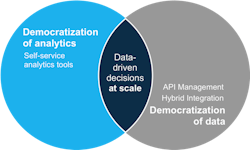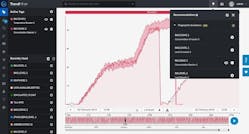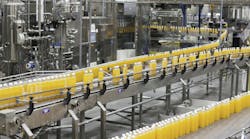Given today’s world economic and geopolitical situations, it is important for process manufacturing companies to make use of technological developments to raise their factories’ operational levels to a new high to weather this difficult period. Moreover, by improving operational performances, process manufacturers will be more economically viable and competitive both now and into the future.
With the use of self-service analytics, process manufacturers can quickly turn their factories into smart factories, which will allow them to leverage the full potential of data and analytics. Companies can use this software to gain new insight and understanding into their operations by integrating time-series and contextual data. Process experts can then monitor, visualize and analyze data for data-driven actions and decision-making.
How to move toward smart manufacturing
Today, everybody is talking about data and its promises to improve overall performance and competitiveness.
Data is practically everywhere and is gathered in each process, including the production process. But data by itself does not do much — it needs to be turned into actionable information. To create a smart factory, the data first needs to be made available to the actual users. Secondly, it needs to be transformed into a format so operational experts can interpret and analyze it. Within operations, production data has been captured for years, so this is a good place to start building your smart factory.
A best-practice approach to building a smart factory is to “start small and scale quick” by leveraging time-series data through self-service advanced analytics.
When the operational specialists can actively use the sensor-generated time-series data captured during production, the first steps to smart manufacturing are taken. The visual representation of the data gives direct insights, but pattern recognition through self-service analytics solutions allows the operational experts to quickly analyze the data. They can find root causes for process anomalies, create soft sensors and monitor operational performance to get early warnings. In this way, actionable information can be created by large groups of users, fast-forwarding efforts to create a smart factory.
Self-service analytics also allows for the democratization of data — where each user has direct access to relevant time-series and contextual data — and at the same time allows for the democratization of analytics, which lets the users take information out of the available data. When both the data — often stored in the data silos of various business applications — and the analytics are put into the hands of the process experts, they can truly make data-driven decisions at scale.
The democratization of data and analytics is key to the success of a smart factory and applies throughout the entire organization. Big data holds a wealth of opportunities to improve operational performance if the data is put in the hands of the process experts. These people have the production knowledge and experience to understand the story it is telling. They are the ones who know what is happening with the production and who can interpret the data if given the chance. With today’s easy-to-use self-service industrial analytics tools, these experts can analyze the data themselves without the help of data scientists, and can thus contribute directly and more fully to improving operational performances and business outcomes.
How Lanxess optimized operations through digitalization and self-service analytics
One example of a company that optimized operations with self-service advanced analytics is LANXESS, a global specialty chemicals company headquartered in Cologne, Germany. LANXESS launched its digitalization initiative in 2017 with the goal of becoming the digital leader in the chemical industry. Its initiative was focused on digitalizing and energizing the entire company value chain and its production facilities by empowering its process experts with a self-service advanced analytics software. With this tool, the LANXESS experts could make data-driven decisions that increased plant capacity, maximized resource efficiency and lowered costs. The results? Savings of up to six figures within six months.
“Thus far, Lanxess has significantly increased its capacity utilization, optimized resource efficiency and reduced maintenance costs. The digital transformation also serves to further develop employees,” said LANXESS CDO Jörg Hellwig. “Competences in the field of digital data analytics will be essential for chemists and chemical engineers in the future.”
Obtain smart manufacturing with self-service advanced analytics
Smart factories allow for technological connectivity and the unprecedented capture and access to process and contextual data, which can be leveraged with self-service advanced analytics.
This solution empowers users on each level of the organization and across departments. It allows them to tap into a process manufacturing plant’s data for a new realm of potential to increase manufacturing operational excellence and business resilience.
However, for organizations to develop business resilience, establish a competitive and sustainable foothold in the market, and be a part of the future of manufacturing, the time is now for organizations to realize their smart factories through the adoption of self-service advanced analytics. That is smart manufacturing.
Tommy Peters is a Customer Success Manager at TrendMiner with management experience of more than 45 projects in different industries and businesses. He focuses on change management and coaching programs to drive successful software adoption.





